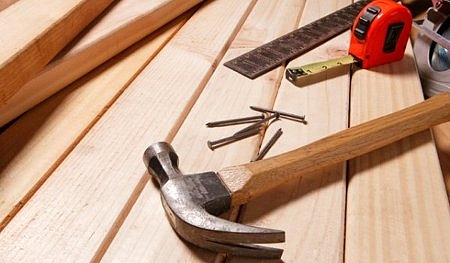Materials, technologies, system – Part four
BAU 2015 is a 180,000 m² showcase of materials, technologies and systems – an area the size of 25 football pitches filled with state-of-the-art technology for the international building and construction industry. In a five-part series, we look at the main focuses in the individual sections at the show. In Part 4, the spotlight is on doors and windows, locks and fittings, and glass.
Doors and windows (Hall B4, C4)
Today customers are wanting doors to be barrier-free, safe and user-friendly in design, and also capable of withstanding the dangers and consequences of climate change, e.g. hurricane-force winds and flooding. Particular attention in this context is being paid to the "zero-millimeter threshold" and the design challenges this presents in terms of thermal bridges and protection against driving rain. New solutions for optimum user comfort are needed in particular for large and heavy components.
In the window segment, child safety is an important factor: products have to some kind of shatter protection, and prevent children falling out or getting crushed by the pane. Another important factor is preventing condensation from forming – this is achieved with well insulated window frames in combination with triple glazing and a warm edge.
In wooden window frames the trend is towards individual designs in decorative woods such as mahogany and cherry. There is also greater attention paid to the use of wood preservatives in window construction. At the same time new materials made from metal and plastics are enabling the development of slimmer yet high-strength window and facade profiles with excellent insulation properties. Also, interest is increasing in ways to exploit windows for solar energy gain. Thanks to new alloys and coatings, considerable savings can be made on maintenance and cleaning input, while also increasing the solar energy yield. At BAU 2015 the manufacturers will be presenting comprehensive information on individual materials such as wood, plastics, glass and aluminum, but also on shutters and sun protection.
Locks / Fittings / Security (Hall B4, C4)
Visitors to BAU will be able to pick up lots of information and advice on locks, cylinders and fittings, as well as anti-intrusion systems, access-control systems and accessories.
For many users, security is a big concern, and the manufacturers are paying particular attention to this in the development of their anti-intrusion products – and the success of these products can be seen in the higher proportion of burglars that are foiled in their attempts to get into buildings. As with the design of windows and doors, the principles of universal design are also being applied to locks and fittings. The aim is to increase comfort and security and to ensure ease of use by all. Automatic operation is one way of meeting these requirements, as it improves efficiency and safety and also offers significant potential for optimizing energy consumption. Not having heating systems running at the same time as the air-conditioning has obvious advantages in this regard, as does regulating indoor air quality by measuring its CO2 content. Other options are a priority ruling for renewable and conventional heating and cooling systems. Significant further potential for saving energy also rests in the use of night-time ventilation, exploiting the thermal storage capacity of a building and lighting that is responsive to daylight levels and occupancy. Electromechanical components are thus playing an ever greater role, including in the area of fittings.
Glass (Hall C2)
The use of more glass in modern architecture is opening up new possibilities but also new challenges. Solutions for efficient solar protection, for example, are becoming ever more important. Pressure-equalized multi-pane insulating glass offers interesting options, in the form of reduced glass thickness, simpler and more efficient integration of light-deflecting and solar-shading systems, and improved sound and thermal insulation. In plus-energy houses in particular, modern glass facades are increasingly being exploited for energy-generation purposes. At IBA 2013 a pilot project was set up consisting of a facade construction made up of photobioreactors: Microalgae are grown in the glass elements on the facade of "BIQ" that create biomass and heat through photosynthesis and solar thermal energy. As well as solutions for energy-generating systems and facades, at BAU 2015 the manufacturers will be presenting new developments in glass building materials, foils, glass constructions and lifts.
About BAU
BAU, the World's Leading Trade Fair for Architecture, Materials and Systems, is the biggest and most important event in the sector. The last event took place from January 14 to 19, 2013 at the Messe München exhibition center. Over 2,000 exhibitors from more than 40 countries and over 235,000 visitors from all around the world took part in the show.
On display at BAU on 180,000 square meters of exhibition space – for years all the available space has been fully booked – are architectural solutions, materials and systems for commercial and residential construction and for interior fit-out, for both new-build and renovation and modernization. Every two years this event brings together market leaders from the sector to participate in a unique international display of competence spanning all the construction trades.
BAU is also the world´s largest trade fair for architects and construction engineers, attracting more than 60,000 design professionals. The exhibits at the fair are organized according to building material and also product and theme areas. Key topics for the future of the industry, such as sustainability and building for life, play an important role in all sections of the exhibition. The many attractive events in the supporting program, including high-caliber forums with experts from all over the world, round off this industry showcase.
The next BAU takes place from January 19 to 24, 2015 at the Messe München exhibition center.
